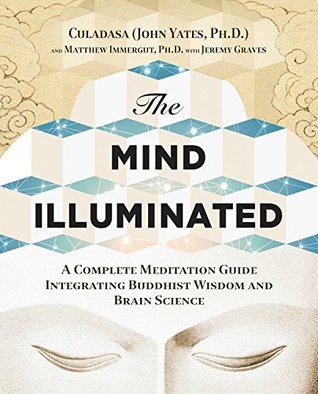More on this book
Community
Kindle Notes & Highlights
Read between
December 11, 2015 - April 16, 2017
Your goals for this Stage are to completely overcome the tendency to slip more deeply into stable subtle dullness, and to heighten the power and clarity of
you want to develop more powerful mindfulness that includes vivid attention and strong peripheral awareness.
the mental agitation that stimulated the mind and helped keep us awake in the earlier Stages, has subsided. As subtle dullness deepens, it causes both peripheral awareness and subtle distractions to fade.
Without guidance, you might confuse a deeper state of subtle dullness with having achieved a Stage Six or Seven level of practice.
Overcoming Subtle Dullness Subtle dullness has three characteristics. 1. The vividness and clarity of the meditation object decline. 2. Both extrospective and introspective peripheral awareness fade. 3. There is a comfortable, relaxed, and pleasant feeling.
The Characteristics of Subtle Dullness
Loss of Vividness
As subtle dullness deepens, the sensations of the breath are no longer as vivid, and your perception of the details isn’t as sharp and clear as before.
An increase in the number of subtle distractions also causes a loss of vividness and clarity. This is because distractions are competing with the breath for available moments of attention.
Yet, this isn’t so easy, because it’s precisely when subtle dullness deepens that introspective awareness starts to fade
The Fading of Extrospective and Introspective Awareness
When subtle dullness deepens, the field of conscious awareness shrinks, sounds and bodily sensations fade from awareness, and thoughts are fewer.
The Pleasure of Dullness
Dullness of any kind is always pleasant, except when you actively resist. You’ll be aware of a sense of comfort and ease, rather than of dullness.
Pleasurable subtle dullness is a trap and a dead end. You must recognize and avoid that trap.
Detecting and Countering the Deepening of Subtle Dullness
The best way to detect subtle dullness is by making introspective awareness stronger. The key to doing that is intention.
The best way to detect subtle dullness is by making introspective awareness stronger. The key to doing that is intention
Now, you must strengthen your introspective awareness. Hold the intention to remain continuously aware of what’s happening in the mind, moment by moment.
Be aware of which subtle distractions are present, and how frequently attention shifts back and forth between them and the breath.
Be aware not only of the contents of your mind—thoughts, feelings, underlying intentions, and so forth—but also of the activities of your mind. At the same time, keep cultivating the intention to observe the meditation object...
This highlight has been truncated due to consecutive passage length restrictions.
stay continuously vigilant about changes in the degree of dullness or alertness of your mind over time. Again, this vigilance is the result of firmly held intentions involving introspective awareness.
By just setting the intention to observe the breath clearly and vividly while sustaining introspective awareness, you directly influence the root cause of dullness.
Use the techniques of following and connecting
when the scope of attention spontaneously expands, it can also disguise an increase in dullness. There are two ways this happens.
never rely on the subjective “feeling” of alertness and clarity. Examine the actual quality of both awareness and attention.
You want to detect any deepening of subtle dullness as soon as possible. Then, apply the appropriate antidote.
Increasing Mindfulness with Body Scanning
Eventually, however, you’ll be able to detect very subtle changes related to the breath in every part of the body. As your sensitivity to these subtle changes increases, you’ll have direct experience of and be able to understand the meaning of traditional terms like “the flow of prāṇa,” “the movement of the inner winds,” and “the circulation of qi.” Wherever you find any changing sensations related to the breath, linger and explore them thoroughly.
Use the body scan when subtle distractions aren’t too strong or numerous, and when your perception of the meditation object and peripheral awareness are both fairly clear.
Always return to the breath at the nose after the body scan. The purpose of this practice is to develop sustained, clear attention to your usual meditation object. Understanding Stage Five from the Moments of Consciousness Model
non-perceiving mind moments,
Increasing the number of perceiving moments of consciousness through intention is the key to increasing your overall power of mindfulness.
intend to detect subtle dullness, we transform non-perceiving, potential moments of consciousness into actual, perceiving moments of introspective awareness
correct for subtle dullness by making our perception more vivid and intense, we transform non-perceiving moments into perceiving moments of attention
Each moment of consciousness with the intention to make peripheral awareness stronger or attention more intense creates other such moments in the future.
these two intentions—the intention to detect dullness and the intention to make perception more vivid and intense—produce even more moments of attention and awareness, and thus greater mindfulness.
intention
intention
recruits still more moments of consciousness, increasing the conscious power of the mind and leading to greater mindfulness.
the ability to consistently sustain and increase your overall mindfulness in each meditation session. Your meditations will steadily improve with each sitting.
Yogācāra
The Mind-System model is a powerful tool. It will give you a much deeper grasp of what you’ve experienced so far, and what’s to come in later Stages.
metacognitive awareness, unification of mind, and no-Self. In short, the Mind-System model is a powerful tool.
conscious mind and the unconscious mind
moments of consciousness from the six categories of sensory experience—visual, auditory, olfactory, gustatory, somatosensory, and mental—and binding moments of consciousness
The Mind-System model recognizes that consciousness is only a small part of the mind—much smaller than the unconscious.
Moments of Consciousness model
active component, intention
conscious intentions can be precursors to mental, verbal, or physical actions.


